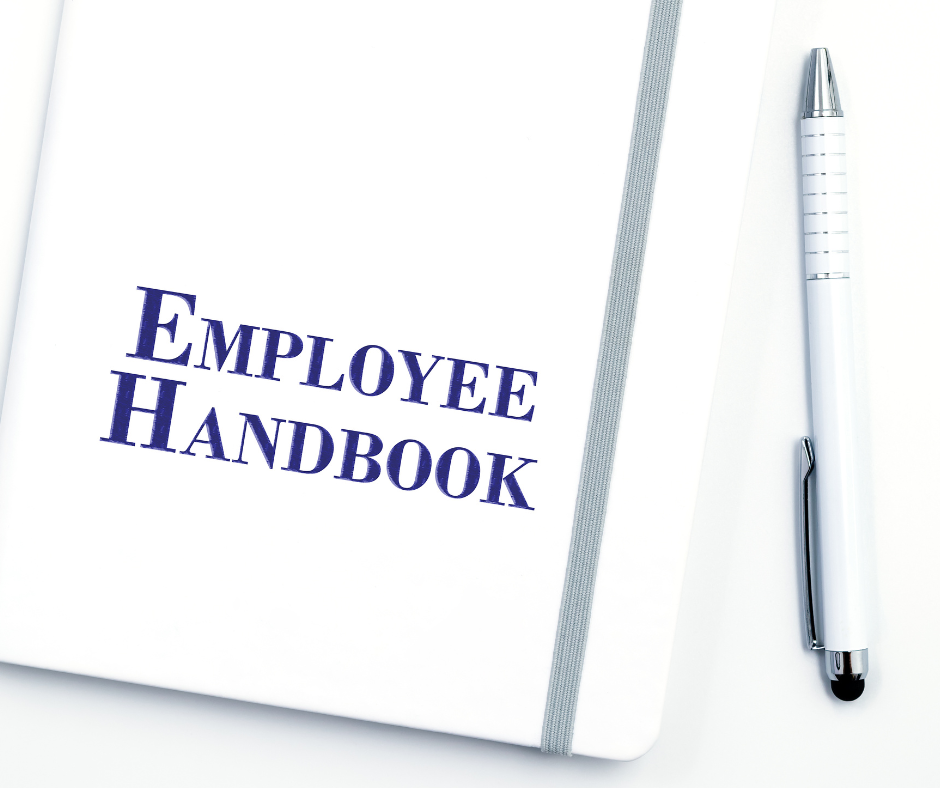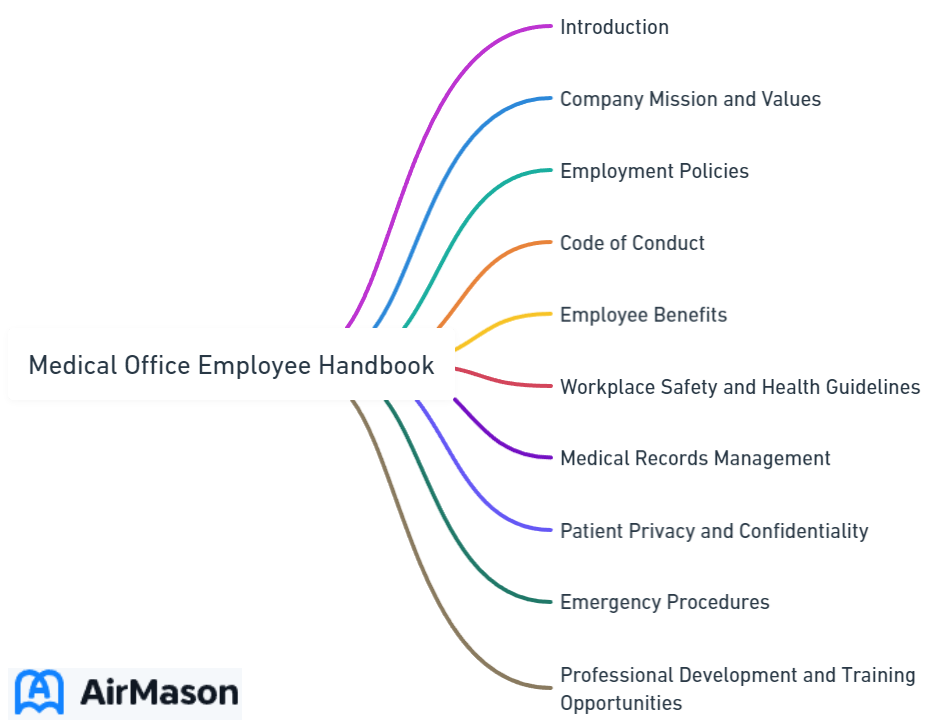
Introduction to the Medical Office Employee Handbook
The Medical Office Employee Handbook serves as a comprehensive guide for employees working in a medical office setting. It outlines the policies, procedures, and guidelines that employees are expected to adhere to, ensuring a harmonious and efficient work environment. This employee handbook is an essential tool for medical offices to communicate expectations, rights, and responsibilities to their staff.
Importance of the Medical Office Employee Handbook
The Medical Office Employee Handbook holds significant importance for both employers and employees. For employers, it provides a clear framework for managing employees, ensuring consistency in policies and procedures, and minimizing the risk of legal issues. It helps establish a professional work culture, improves employee morale, and facilitates the efficient operation of the medical office.
For employees, the employee handbook serves as a valuable resource for understanding their rights and responsibilities, as well as the expectations set forth by the medical office. It provides guidance on various aspects of employment, including dress code, attendance, confidentiality, and code of conduct. Having access to this handbook ensures that employees are well-informed and can navigate their roles within the medical office effectively.
By addressing various policies, procedures, and job-specific guidelines, the Medical Office Employee Handbook promotes a productive and harmonious work environment, ultimately benefiting both the medical office and its employees.

Importance of the Medical Office Employee Handbook
The importance of the Medical Office Employee Handbook cannot be overstated in a healthcare setting. It plays a crucial role in ensuring the smooth operations of the office, maintaining compliance with legal requirements, and fostering a positive work environment. The handbook serves multiple purposes and provides numerous benefits to both the employees and the organization.
One of the key benefits of the handbook is standardization. It sets forth policies and procedures that are to be followed by all employees, promoting consistency and ensuring that everyone understands their roles and expectations. This uniformity helps in creating a harmonious work environment.
Compliance is another vital aspect addressed in the handbook. It outlines the legal requirements that the office must adhere to, including patient privacy regulations (such as HIPAA), workplace safety guidelines, and standards of ethical conduct. By clearly communicating these requirements, the handbook helps in reducing the risk of legal violations and protecting the reputation of the office.
Effective communication is essential for any organization, and the handbook facilitates this by providing essential information about the medical office. It includes details about the organization’s mission, values, and goals, as well as the chain of command and reporting procedures. Employees can refer to the handbook for guidance, ensuring that they are well-informed about the office’s policies and structure.
Serving as a valuable reference guide, the handbook allows employees to find answers to frequently asked questions, saving them time and energy. It consolidates important information in one place, making it easily accessible for employees seeking guidance.
Conflicts and misunderstandings are inevitable in any workplace, but the handbook provides a framework for effective dispute resolution. By outlining the steps and processes to follow in such situations, it helps in resolving conflicts in a fair and structured manner, fostering a more positive work environment.
The handbook also sets clear expectations for employee behavior and performance. It outlines professional conduct, dress code guidelines, attendance policies, and performance expectations. By establishing these expectations, the handbook enables employees to understand what is required of them and helps in maintaining a professional and productive workplace.
Additionally, the handbook may include information about training programs and opportunities for professional development. This demonstrates the organization’s commitment to employee growth and encourages continuous learning and improvement.
Lastly, the handbook promotes a safe work environment by outlining safety protocols and emergency procedures. By providing employees with the necessary information and guidelines to follow in case of emergencies or accidents, the handbook helps in minimizing risks and ensuring the well-being of everyone in the office.
General Policies and Procedures
Looking for clarity on the general policies and procedures at a medical office? You’re in the right place! In this section, we’ll cover the essential aspects of the employee handbook. From discussing the importance of adhering to the dress code and appearance guidelines to highlighting the significance of punctuality and attendance, we’ll ensure you’re well-versed in the expectations. Moreover, we’ll touch upon the crucial topics of confidentiality and data security, as well as the code of conduct that fosters a professional working environment.
Dress Code and Appearance
When it comes to the dress code and appearance in a medical office, it’s crucial to maintain a professional and presentable image. Here are some guidelines to consider:
- Appropriate attire: Employees should wear clean and neat clothing suitable for a professional healthcare environment. This includes scrubs, lab coats, or professional attire based on the job role.
- Personal hygiene: Employees must maintain good personal hygiene by showering regularly, using deodorant, and keeping hair clean and well-groomed. Maintaining a clean and professional appearance contributes to a positive work environment.
- Footwear: Employees should wear closed-toe shoes for safety. Comfortable and supportive shoes are especially important for long periods of standing.
- Accessories and jewelry: Employees should wear minimal and non-distracting accessories. Excessive jewelry, large earrings, or dangling bracelets can interfere with work tasks and patient care.
- Tattoos and piercings: Visible tattoos and multiple piercings should be covered or minimized. Limit facial piercings to one per ear, and all body piercings should follow industry standards and policies.
- Professional grooming: Employees should maintain a clean-shaven or neatly groomed beard. Avoid excessive use of perfume, cologne, or scented products that may cause discomfort or allergies for patients or co-workers.
- Uniform policy: Strictly adhere to specific uniforms or dress code requirements set by the medical office. Any changes or exceptions to the dress code policy must be approved by management.
Following these dress code and appearance guidelines helps create a professional and positive image for the medical office, contributing to a comfortable environment for both employees and patients.
Attendance and Punctuality
When it comes to attendance and punctuality in the workplace, there are several important factors to consider. First and foremost, it is crucial to arrive on time for work. Being punctual ensures that workflow is not disrupted and productivity is not affected.
It is also advisable to plan ahead, especially when it comes to your commute. Accounting for potential delays such as traffic or issues with public transportation can help you arrive on time.
Additionally, if you anticipate being late or unable to attend work, it is essential to notify your supervisor or team members in advance. This allows for proper planning and ensures that your absence is properly communicated.
Familiarizing yourself with the company’s attendance policies is also important. This includes understanding the procedures for requesting time off or reporting absences.
Keeping a record of your attendance and punctuality is highly recommended. This will help ensure accuracy and address any discrepancies promptly. Being accountable for your attendance and punctuality is crucial. If you face challenges in this regard, it is best to openly communicate with your supervisor and work towards finding solutions.
By setting a positive example in terms of attendance and punctuality, you contribute to a healthy and efficient work environment. It is important to remember that consistent attendance and punctuality not only reflect professionalism and commitment but also contribute to the overall success of the organization.
Confidentiality and Data Security
Confidentiality and data security are of utmost importance in any medical office employee handbook, as these policies are crucial for protecting sensitive information and maintaining trust.
- Confidentiality: It is imperative for employees to fully comprehend the significance of upholding patient confidentiality. Personal and medical information must be kept strictly confidential at all times. This entails refraining from discussing sensitive information outside of the office and ensuring the secure handling and storage of documents.
- Data security: The safeguarding of patient data from unauthorized access or breaches is of paramount importance. Employees should strictly adhere to security protocols, including the use of secure passwords, regular software updates, and secure transmission of electronic data. They should also remain vigilant against phishing attempts and other cyber threats.
- Data sharing: Employees should only share patient information when authorized or when required by law, such as when coordinating care with other healthcare professionals. It is essential that such sharing is done securely, following designated protocols and utilizing secure communication channels.
- Staff training: Regular training sessions should be provided to employees to ensure they are well-versed in the latest security measures and understand the importance of confidentiality. Employees should be equipped to identify and promptly report any potential security breaches.
By incorporating these policies into the medical office employee handbook, the confidentiality and data security of patient information can be effectively maintained. This not only safeguards patient privacy and preserves trust, but also ensures compliance with legal requirements.
It is important to periodically review and update these policies to keep up with the constantly evolving technology and security threats. Additionally, designating a staff member responsible for overseeing and enforcing confidentiality and data security measures will help maintain consistency and accountability.
Code of Conduct
The Code of Conduct is crucial in any medical office employee handbook. It establishes standards and expectations for employee behavior and professionalism. Some key points to consider include:
1. Treat everyone with respect and courtesy, regardless of position or background, to create a positive and inclusive work environment.
2. Follow ethical guidelines and maintain integrity in all interactions with patients, colleagues, and stakeholders.
3. Protect patient confidentiality and adhere to data security protocols to prioritize patient privacy.
4. Avoid conflicts of interest that could compromise care quality or the office’s reputation.
5. Comply with healthcare laws, regulations, and policies, including HIPAA.
6. Report any unethical or illegal behavior observed in the workplace to foster transparency and accountability.
7. Use technology, equipment, and resources responsibly and efficiently, reporting any misuse or potential security breaches.
8. Participate in ongoing professional development and training to enhance knowledge and skills.
9. Adhere to punctuality and attendance policies for smooth operation of the medical office.
10. Emphasize teamwork, collaboration, and effective communication for optimal patient care.

Employment Policies
In this section, we’ll dive into the essential employment policies that form the backbone of the medical office employee handbook. From equal opportunity to anti-harassment policies, drug and alcohol regulations to social media and internet usage guidelines, and comprehensive benefits and leave policies – as well as their alignment with your nonprofit organization employee handbook – we’ll explore the crucial aspects that shape the work environment of the medical office. So, get ready to uncover the policies that ensure fairness, respect, and professionalism in every aspect of employment.
Equal Opportunity Policy
The Equal Opportunity Policy is an essential part of the medical office employee handbook. It promotes fairness and prohibits discrimination in the workplace. Important aspects to consider include:
1. The policy ensures that all employees are treated fairly and equally, regardless of race, gender, age, religion, disability, or other protected characteristics.
2. It prohibits discrimination in hiring, promotions, compensation, and opportunities for training and development.
3. The policy also prohibits harassment based on protected characteristics, such as sexual harassment or racial slurs.
4. Employees are encouraged to report instances of discrimination or harassment to their supervisor or HR representative.
5. The company will promptly investigate reported incidents and take appropriate disciplinary action if necessary.
By implementing and enforcing the Equal Opportunity Policy, the medical office fosters a diverse and inclusive work environment where everyone has an equal chance to succeed and contribute to the organization’s success.
Fact: A study by the Pew Research Center shows that workplace diversity improves innovation, problem-solving, and decision-making in organizations.
Anti-Harassment Policy
The Anti-Harassment Policy is an essential part of the Medical Office Employee Handbook. It creates a safe and respectful working environment for all employees. The policy provides clear guidelines and expectations for preventing and responding to harassment.
This policy prohibits all forms of harassment, including sexual harassment, physical or verbal abuse, offensive comments, and discrimination based on race, gender, religion, or disability. Harassment negatively affects employee morale, productivity, and job satisfaction.
The policy emphasizes the prompt reporting of harassment incidents. Employees are encouraged to report any misconduct or harassment they have witnessed or experienced through designated reporting mechanisms such as the human resources department or a dedicated hotline.
Upon receiving a report, a thorough investigation will be conducted while ensuring confidentiality as much as possible. Disciplinary action, ranging from verbal warnings to termination, will be taken against individuals found responsible for harassment, based on the severity of the offense.
Regular training and awareness programs will be carried out to educate employees about the policy, their rights, and responsibilities. By promoting a culture of respect and accountability, the organization aims to prevent harassment and create a harmonious work environment for everyone.
Drug and Alcohol Policy
In a medical office, having clear guidelines and procedures is crucial to maintain a safe and professional environment. Here are important aspects to consider:
- All employees must abide by the Drug and Alcohol Policy and are strictly prohibited from using or being under the influence of drugs or alcohol while on duty.
- Regular drug and alcohol testing will be performed to ensure compliance with the policy and to identify any potential substance abuse issues.
- Employees found in violation of the policy may face disciplinary actions, ranging from suspension to termination, depending on the severity of the offense.
- Provide information and resources to employees struggling with drug or alcohol addiction, including access to rehabilitation programs or counseling services.
- Train supervisors and managers to recognize signs of drug or alcohol abuse and handle situations involving substance abuse in the workplace.
- Confidentiality is crucial when addressing drug and alcohol-related issues. All information regarding an employee’s substance abuse must be kept private and only disclosed on a need-to-know basis.
Implementing a comprehensive Drug and Alcohol Policy ensures the safety of both employees and patients while maintaining a professional and productive work environment.
Social Media and Internet Usage Policy
A comprehensive Social Media and Internet Usage Policy is essential for medical offices to ensure responsible use by employees in the workplace. Implementing a clear policy helps define acceptable usage and guidelines for appropriate social media and internet use during work hours. This policy also emphasizes the importance of protecting patient confidentiality by prohibiting the posting of patient information, photos, or discussions about specific cases on social media platforms.
Another crucial aspect of the policy is the prohibition of harassment and discrimination, both in the workplace and on social media platforms. By making it clear that any form of harassment or discrimination will not be tolerated, employees are aware of the consequences of engaging in such behavior online.
Furthermore, the policy encourages professional conduct by reminding employees that their online presence reflects on the office’s reputation. Negative or offensive posts that could damage the office’s image should be avoided.
In terms of cybersecurity, the policy emphasizes the importance of password security and the non-sharing of login information. Employees should regularly update their passwords to protect sensitive information and to prevent unauthorized access to company accounts.
Moreover, the policy states that the office reserves the right to monitor internet and social media usage. Violations of the policy may result in disciplinary action, up to and including termination.
Benefits and Leave Policies
Benefits and leave policies are crucial in a medical office employee handbook. They play a significant role in providing employees with comprehensive information regarding their entitlements, rights, and responsibilities concerning time off and benefits.
One of the essential aspects covered in these policies is vacation and paid time off. Employees are given a specific number of vacation days or paid time off annually, which they can utilize for personal reasons or to rejuvenate themselves.
Another important aspect is sick leave and medical absences. Employees are allotted a certain number of sick days per year to manage their health or take care of their family members’ well-being.
Additionally, the policy of family and medical leave grants employees the opportunity to take time off for family or medical reasons. This includes situations such as the birth or adoption of a child, caregiving for a family member with a serious health condition, or dealing with their own serious health condition.
Furthermore, the medical office provides detailed information regarding employee benefits and insurance. This encompasses health insurance, dental insurance, life insurance, retirement plans, and various additional benefits.
By implementing these comprehensive policies, employees are ensured a healthy work-life balance, allowing them to prioritize their physical and mental well-being. It is crucial for employees to familiarize themselves with these policies to fully comprehend their rights and responsibilities concerning time off and benefits.
Vacation and Paid Time Off
When it comes to vacation and paid time off, employees must understand the policies and procedures in place. Here are some key considerations to keep in mind:
1. Accrual: Employees receive vacation time based on their length of service or a set schedule. For instance, employees may accumulate 1 day of vacation per month worked.
2. Usage: It’s important for employees to be aware of any restrictions on when and how they can utilize their vacation time. This could include blackout periods during busy seasons or the need to request time off in advance.
3. Pay: Vacation time is paid, which means that employees continue to receive their regular salary or hourly rate.
4. Carryover: While some employers allow vacation time to be carried over to the following year, others have a “use it or lose it” policy where any unused vacation time is forfeited.
5. Additional benefits: In some cases, employers may offer the option to purchase extra vacation days or provide flexibility in scheduling vacations.
Employees should take the time to plan and utilize their vacation time wisely, taking into account both work obligations and personal needs. Effective communication with supervisors and adherence to proper procedures are crucial for a smooth arrangement.
By fully understanding and following the vacation and paid time off policies, employees can enjoy their time away from work while still maintaining a healthy work-life balance.
Sick Leave and Medical Absences
Sick leave and medical absences are vital components for both employees and employers. Understanding these aspects is crucial, so consider the following key points:
1. Sick leave entitlement: It is essential for employees to be aware of the amount of sick leave they are entitled to. This information can typically be found in the employee handbook or employment contract.
2. Notification requirements: In the event of illness preventing an employee from working, it is necessary for them to promptly notify their employer. Some companies may also require a doctor’s note for extended absences.
3. Accrual of sick leave: Sick leave can accumulate over time or be provided as a predetermined number of days per year. Employees should be familiar with how sick leave accrual works, as well as any restrictions on carryover or usage.
4. Utilizing sick leave: Employees should adhere to company procedures when requesting and documenting sick leave usage. This may involve completing a time-off request form or informing a supervisor.
5. Additional benefits: Certain companies offer extra benefits such as short-term disability or paid medical leave for serious health conditions. It is important for employees to comprehend these benefits in order to make informed decisions.
Fact: According to the U.S. Bureau of Labor Statistics (March 2021), private industry employers typically grant an average of 8 sick days per year to full-time employees.
Family and Medical Leave
Family and Medical Leave allows employees to take time off work for family and medical reasons. Key points to consider include eligibility, reasons for leave, duration, notification, job protection, and healthcare benefits.
To be eligible for family and medical leave, employees must have worked for the company for at least 12 months and have worked a minimum of 1,250 hours. Leave can be taken for reasons such as the birth or adoption of a child, caring for a seriously ill family member, or managing one’s own serious health condition.
Eligible employees can take up to 12 weeks of unpaid leave within a 12-month period. Employees need to provide notice to their employer and include the reason for the leave and the expected duration. The policy ensures job protection and allows employees to maintain their healthcare benefits. Family and Medical Leave supports employees in balancing their work and personal lives and shows employers’ commitment to their employees’ well-being.
In a true story, John, an employee at a medical office, recently used his entitlement to family and medical leave when his wife gave birth to their first child. This allowed John to support his wife during the delivery and care for their newborn without worrying about his job. The medical office was supportive and made the necessary arrangements to cover John’s workload. The policy provided peace of mind, allowing John to bond with his newborn and adjust to his new role as a father.
Moreover, this situation serves as an effective employee handbook example, illustrating how well-implemented policies can create a positive and supportive work environment for employees during significant life events.
Employee Benefits and Insurance
When it comes to employee benefits and insurance, a medical office employee handbook should provide clear guidelines and information. Here are some key points to consider:
1. Type of benefits: The handbook should outline the specific employee benefits offered, such as health insurance, dental and vision coverage, retirement plans, and other additional benefits.
2. Eligibility and enrollment: Specify the criteria for employees to qualify for benefits and the process and deadlines for enrolling in benefit programs.
3. Coverage details: Provide specific information about deductibles, co-pays, and any restrictions or limitations related to insurance.
4. Insurance providers: Clearly state the insurance providers that the medical office has partnered with to provide employee benefits. This helps employees know which healthcare providers are in-network.
5. Employee contributions: Explain any employee contributions or premiums for benefits and include details about payment methods such as payroll deductions.
6. Additional insurance options: Mention any other insurance options available, such as life insurance, disability insurance, or flexible spending accounts (FSAs).
By including comprehensive information about employee benefits and insurance in the medical office employee handbook, employees will have a clear understanding of the available options and can make informed decisions about their healthcare coverage and financial planning.
Providing employee benefits and insurance is crucial for attracting and retaining talented professionals in the healthcare industry. Competitive benefit packages not only attract top talent but also demonstrate the medical office’s commitment to the well-being and financial security of its employees. Employee benefits and insurance play a vital role in ensuring that employees have access to quality healthcare services and can focus on their work and patient care.

Safety and Emergency Procedures
Being prepared for emergencies is crucial in any medical office. In this section, we will explore the importance of safety and emergency procedures, covering sub-sections such as emergency evacuation, fire safety, and first aid and injury reporting. Learn how to navigate potential hazards and ensure the well-being of both patients and staff. Stay tuned for practical guidelines and tips to maintain a secure environment within the medical office setting.
Emergency Evacuation
Emergency evacuation is of utmost importance when it comes to the safety and well-being of medical office employees. It is essential to have a clear plan and proper procedures in place to ensure an efficient and swift evacuation of the building.
To begin with, it is crucial to know the location of all emergency exits. These exits should be clearly marked and easily accessible, so all employees are familiar with them. Following the evacuation procedures outlined in the medical office employee handbook is also critical during emergencies. These procedures include sounding an alarm, notifying authorities, and guiding patients and staff to the designated assembly area.
During an emergency evacuation, it is important to stay calm and be alert. Employees should follow the instructions provided by designated personnel and offer assistance to anyone in need. It is advised to avoid using elevators in most cases and opt for the stairs to safely exit the building.
After evacuating the building, it is essential to ensure that all employees and patients have safely made it out. Accounting for everyone will prevent anyone from being left behind. The medical office employee handbook provides detailed guidelines and protocols for emergency evacuation, ensuring the safety of all individuals during unforeseen circumstances.
Being prepared and knowledgeable about these procedures allows employees to effectively respond to emergencies and minimize risks. This, in turn, ensures the well-being of everyone involved.
Fire Safety
Fire Safety is crucial for maintaining a safe medical office. To ensure employee and patient safety, the following measures should be implemented:
1. Fire prevention: Conduct regular inspections to identify potential fire hazards like faulty wiring, overloaded outlets, or flammable materials. Keep the workspace clean and clutter-free to minimize the risk of fire.
2. Fire extinguishers: Place adequate fire extinguishers strategically throughout the office, especially near high-risk areas like the kitchen or storage rooms. Train all employees on proper fire extinguisher usage in case of an emergency.
3. Emergency evacuation plan: Develop a well-defined emergency evacuation plan and communicate it to all employees. Include designated escape routes, assembly points, and procedures for assisting patients with disabilities or mobility issues.
4. Smoke alarms and detectors: Install working smoke alarms and detectors in appropriate areas to provide early fire warning. Regularly maintain and test these devices to ensure they are functioning properly.
5. Employee training: Provide comprehensive training to all employees on fire safety protocols, including how to respond to a fire emergency, locate fire exits, and remain calm during evacuations.
6. Regular drills: Conduct regular fire drills to familiarize employees with emergency evacuation procedures. Identify any gaps in the plan and make necessary adjustments.
Prioritizing fire safety in medical offices creates a secure environment for employees and patients. Remember, prevention and preparedness minimize the risks associated with workplace fires.
First Aid and Injury Reporting
When it comes to first aid and injury reporting in a medical office, follow these steps to ensure safety for patients and employees.
– Assess the situation: Determine if immediate medical attention is needed.
– Provide first aid: Clean wounds, apply bandages, or provide ice packs for swelling in minor injuries.
– Document the incident: Accurately record the date, time, location, and details of the incident.
– Notify the appropriate authorities: Contact emergency services or the designated safety officer for serious injuries.
– Report the incident: Follow the established protocol and complete necessary paperwork for injury reporting.
– Provide support and follow-up: Offer information on necessary follow-up care or appointments to the injured individual.
– Implement preventive measures: Identify the cause of the injury and take steps to prevent similar incidents in the future.
By following these steps, a medical office can provide proper first aid, effectively document and report injuries, and create a safe environment.

Job-Specific Policies and Procedures
Looking to navigate the ins and outs of your medical office job? In this section, we’ll uncover the vital details that make up your job-specific policies and procedures. From job descriptions and responsibilities to training and development opportunities, performance evaluation and promotion, and even technology and equipment usage – we’ve got you covered. Get ready to dive into the nitty-gritty essentials that will empower you to excel in your medical office role.
Job Descriptions and Responsibilities
Job Descriptions and Responsibilities in a medical office employee handbook are crucial for effectively managing staff roles and duties. These descriptions provide clarity and ensure that everyone understands their specific responsibilities. Key points to consider include:
1. Clearly defined job roles: Each position should have a detailed description outlining specific duties and responsibilities. This helps employees understand expectations.
2. Qualifications and requirements: Descriptions should include necessary qualifications, certifications, and skills for each position. This ensures employees have the appropriate qualifications.
3. Reporting structure: Descriptions should outline who employees report to and who they supervise, if applicable.
4. Key responsibilities: Main responsibilities for each position should be clearly stated, such as patient scheduling, medical records management, billing, or clinical duties.
5. Performance expectations: Descriptions should include performance expectations and goals for each position. These can be used for evaluations and promotions.
6. Collaboration and teamwork: Descriptions should emphasize the importance of collaboration and teamwork, including positive relationships and a supportive work environment.
7. Additional duties: Descriptions should highlight any additional responsibilities, such as training programs, staff meetings, or special projects.
8. Professional conduct: Expectations for professional conduct should be included, such as adhering to the code of ethics, patient confidentiality, and laws/regulations.
By clearly outlining job descriptions and responsibilities, medical offices can ensure that all employees understand their roles, perform effectively, and contribute to a harmonious and efficient work environment.
Training and Development Opportunities
Training and development opportunities are crucial for the growth and success of employees in a medical office. It is important to consider the following options:
1. On-the-job training: In medical offices, employees receive training to become familiar with their roles. This includes shadowing experienced staff, attending workshops, and engaging in hands-on practice.
2. Continuing education: Medical offices provide opportunities for further education and professional development. This can include attending conferences, workshops, or webinars to stay updated in the field.
3. Certification programs: Certain positions in a medical office require specific certifications. Employers support their employees by providing study materials, financial assistance, or paid time off for exam preparation to obtain these certifications.
4. Mentorship programs: Pairing employees with experienced mentors provides guidance and facilitates knowledge sharing. Mentors offer advice, support, and help employees navigate their career paths.
To maximize training and development opportunities, consider the following suggestions:
– Be proactive: Show enthusiasm for growth by actively seeking out and participating in available training programs.
– Set goals: Identify areas for improvement and set specific, achievable goals to guide your efforts.
– Network: Take advantage of networking opportunities to connect with professionals in your field for insights and future prospects.
– Apply new skills: After completing training, apply what you’ve learned in your work to solidify your skills and demonstrate value to your employer.
Performance Evaluation and Promotion
To effectively evaluate and promote employee performance in a medical office, it is important to consider the following factors:
– Performance Evaluation Criteria: Examples include assessing the quality of work, such as the accuracy of medical records and efficiency in patient care. It also involves evaluating productivity, such as the number of patients seen and completion of administrative tasks. Additionally, teamwork and collaboration with colleagues, as well as communication skills including effective patient communication and clear instructions to colleagues, are essential. Lastly, adaptability, which refers to the ability to handle change and willingness to learn new skills, is also a key evaluation factor.
– It is crucial to conduct performance evaluations on a regular basis, either annually or biannually. This will provide feedback to employees and help identify areas for improvement. The evaluation process aids in recognizing both strengths and weaknesses, setting performance goals, and establishing career development plans.
– Promotions within a medical office are based on merit, qualifications, and performance. Employees who consistently excel and meet the requirements for higher positions may be considered for advancement opportunities. These opportunities can involve greater responsibility or specialization.
– It is imperative for employees to have a clear understanding of the evaluation criteria and the promotion process. This can be achieved through clear communication about expectations and career opportunities, which fosters motivation and engagement among the workforce.
– Regular review and updating of performance evaluation criteria is essential to ensure alignment with evolving needs. Moreover, it enables the recognition and promotion of talented individuals who contribute to the organization’s success.
Technology and Equipment Usage
The medical office uses technology and equipment to improve efficiency and provide quality care to patients. They utilize an Electronic Medical Records (EMR) system for digital storage, organization, and retrieval of patient medical records. Diagnostic equipment, such as X-ray machines, ultrasound scanners, and electrocardiographs, aids in accurate diagnosis and informed treatment decisions. Telemedicine technology, including video conferencing and remote monitoring tools, facilitates virtual consultations and timely medical advice. Communication systems like VoIP phones, messaging platforms, and email services streamline communication.
Additionally, these technological advancements are in line with our target team member handbook, ensuring that our staff is well-equipped to utilize these tools effectively, maintain patient privacy, and provide the highest level of care. Data security measures, such as encryption methods, firewalls, and strict access controls, protect patient information.
Pro-tip: Medical office staff should stay updated on the latest technology and equipment advancements relevant to their roles to improve productivity and enhance patient care.
Frequently Asked Questions
1. What is a medical office employee handbook?
A medical office employee handbook is a resource that provides information on terms and conditions of employment in a medical business. It includes details about benefits like paid time off and health insurance, as well as guidelines and expectations for employees.
2. Why is a medical office employee handbook important?
A medical office employee handbook is important for several reasons. It serves as a reference guide for employees to understand their rights, responsibilities, and obligations. It also helps in preventing misunderstandings that can lead to legal disputes, provides legal protection, communicates expectations, explains employee rights and privileges, ensures legal compliance, and introduces new hires to the practice’s culture and expectations.
3. What should be included in a medical office employee handbook regarding leaves of absence?
A medical office employee handbook should clearly outline policies and procedures related to leaves of absence. This includes information on how to request and provide notice for leaves, the types of leaves available (such as sick leave, family and medical leave, or unpaid leave), and any requirements for documentation or approval.
4. What is the importance of workers’ compensation insurance mentioned in the handbook?
Workers’ compensation insurance is important as it provides coverage for work-related injuries or illnesses. The handbook may outline the company’s policy on reporting injuries promptly, the process for seeking medical help, and how the insurance provider will manage the injured employee’s return to work. This information ensures employees understand their rights and obligations in the event of a work-related injury.
5. How does open communication play a role in the medical office employee handbook?
The medical office employee handbook may emphasize the importance of open communication in the workplace. This can include encouraging employees to report any ethical issues or unethical practices they observe or learn about, providing channels for anonymous reporting, and outlining the company’s commitment to maintaining a safe and respectful work environment. Open communication helps foster trust and transparency within the healthcare practice.
6. Is HR software mentioned in the handbook beneficial for managing the employee handbook?
Yes, HR software like HR for Health can be beneficial for managing the employee handbook. It assists in creating a comprehensive document tailored to specific state and industry requirements. The software provides easy access to information for employees and automatically updates the handbook based on new HR laws, ensuring everyone has the latest version. This streamlines the creation and management of the employee handbook, saving time and effort for HR professionals.
